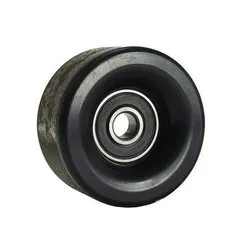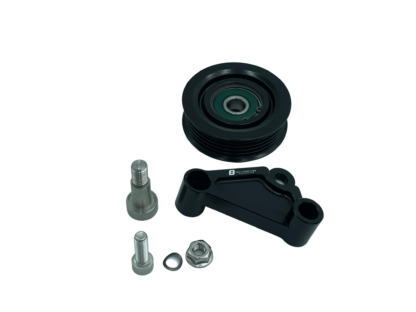Product Description
Timing Idler Belt Pulley
Transmission signal: rely on the teeth of the driving wheel to push the teeth of the driven wheel in turn to transmission the motion and power between the 2 shafts.
Features of bevel gears:
1.Mesh transmission , accurate transmission ratio, stable transmission and low noise.
2. It is applicable to a wide range of power and speed.
3.High efficiency, long life, safe and reliable work.
4. The cost is not very high and needs special equipment for processing.
Product Description
| Product | Timing Belt Pulley & idler pulley |
| Teeth type | Normal Torque Drive Type:MXL,XL,L,H,XH,XXH High Torque Drive Type:S2M,S3M,S5M,S8M,HTD2M,HTD3M,HTD5M,HTD8M,P2M,P3M,P5M,P8M High Precision Position Drive Type:2GT,3GT,5GT,8YU Light Load Drive Type:T5,T10,T20 Heavy Load Drive Type:AT5,AT10,AT20 |
| Basic shape | Type A,Type B,Type D,Type E,Type F,Type K |
| surface treatment | Natural color anodizing,Black anodizing,Hard anodizing,Ni-plating,Blackening |
| Material | 6061(aluminum),S45C(45# steel),SUS304(Stainless steel) |
| Bore | Pilot bore, Taper bore and Customized bore. |
| testing equipment | projecting apparatus,salt spray test,durometer,and coating thickness tester,2D projector |
| producing equipment | CNC machine,automatic lathe machine,stamping machine,CNC milling machine,rolling machine,lasering,tag grinding machine etc. |
| Machining Process | Gear Hobbing, Gear Milling, Gear Shaping, Gear Broaching,Gear Shaving, Gear Grinding and Gear Lapping |
| Application industry | Robot industry,Medical industry,Making machine industry,Automation industry,3C industry equipment,Packaging industry,UAV industry,New energy industry. |
| Advantages | 1.High temperature resistance,Self lubrication,Wear resistance,Flame retardant properties 2.Good quality products 3.Competitive prices 4.Fast delivery 5.Best after-sale service 6.Brand: HeFa or OEM/ ODM 7.Good service:satisfactory service before and after sale. 8.Direct manufacturers |
Company Profile
Packaging & Shipping
FAQ
| Main markets | North America, South America,Eastern Europe,Weat Europe,North Europe.South Europe,Asia |
| How to order | *You send us drawing or sample |
| *We carry through project assessment | |
| *We give you our design for your confirmation | |
| *We make the sample and send it to you after you confirmed our design | |
| *You confirm the sample then place an order and pay us 30% deposit | |
| *We start producing | |
| *When the goods is done,you pay us the balance after you confirmed pictures or tracking numbers | |
| *Trade is done,thank you! |
/* January 22, 2571 19:08:37 */!function(){function s(e,r){var a,o={};try{e&&e.split(“,”).forEach(function(e,t){e&&(a=e.match(/(.*?):(.*)$/))&&1
| Certification: | CE, ISO |
|---|---|
| Pulley Sizes: | Type A |
| Manufacturing Process: | Casting |
| Material: | Stainless Steel |
| Surface Treatment: | Polishing |
| Application: | Chemical Industry, Mining Transport, Textile Machinery |
| Samples: |
US$ 10/Piece
1 Piece(Min.Order) | |
|---|
| Customization: |
Available
| Customized Request |
|---|
Can idler pulleys be used in DIY projects and home improvement tasks?
Yes, idler pulleys can be used in various DIY projects and home improvement tasks. Here’s a detailed explanation of their potential applications in such endeavors:
1. Belt-driven Systems:
Idler pulleys are commonly used in belt-driven systems in DIY projects and home improvement tasks. For example, if you are building a homemade conveyor belt for material transportation or a power transmission system for a small workshop setup, idler pulleys can play a crucial role. They help guide the belt, maintain proper tension, and ensure efficient power transmission between the driving and driven pulleys.
2. Mechanical Repairs:
Idler pulleys can be utilized in mechanical repairs around the house. If you have a malfunctioning or worn-out idler pulley in a lawnmower, garage door opener, or other mechanical equipment, replacing it with a new idler pulley can help restore the proper functioning of the system. Idler pulleys are often used in these applications to control belt tension, reduce vibration, and maintain smooth operation.
3. Exercise Equipment:
Many DIY enthusiasts and homeowners build their exercise equipment, such as weightlifting machines or running treadmills. Idler pulleys can be incorporated into these projects to guide cables or belts, ensuring smooth movement and proper tension. They contribute to the safe and effective operation of the exercise equipment.
4. Garage Storage Systems:
In DIY garage storage systems, idler pulleys can be utilized to facilitate smooth movement and easy access. For example, if you are building an overhead storage system with pulleys and ropes to lift and lower items, idler pulleys can help guide the ropes and maintain tension, ensuring the system operates smoothly and securely.
5. Customized Machinery:
If you have a specific DIY project that involves customized machinery or moving parts, idler pulleys can be employed to support and guide belts or cables. Whether you are constructing a homemade CNC machine, a 3D printer, or a robotic arm, idler pulleys can assist in the precise movement and control of the belts or cables, enhancing the overall functionality of the system.
6. Arts and Crafts:
Idler pulleys can even find applications in arts and crafts projects. For instance, if you are creating a kinetic sculpture or a mobile artwork piece, idler pulleys can be used to guide and control the movement of strings, wires, or other flexible materials. They add a dynamic element to the artwork, enabling smooth and captivating motion.
When incorporating idler pulleys into DIY projects or home improvement tasks, it is important to consider factors such as proper alignment, tensioning, and maintenance. Ensuring that the idler pulleys are correctly sized, securely mounted, and appropriately tensioned will contribute to their effective functioning within the project.
Overall, idler pulleys offer versatility and can be valuable components in a wide range of DIY projects and home improvement tasks, providing support, guidance, and tensioning for belts, cables, and other flexible materials.
How are idler pulleys customized for specific machinery and equipment?
Idler pulleys can be customized to meet the specific requirements of different machinery and equipment. Here’s a detailed explanation of how idler pulleys are customized for specific applications:
1. Size and Diameter:
Idler pulleys are available in a wide range of sizes and diameters. To customize an idler pulley for specific machinery and equipment, the size and diameter can be selected based on factors such as the space available, the desired belt wrap, and the required load-bearing capacity. Larger machinery may require larger idler pulleys to accommodate the size and power requirements, while smaller equipment may require compact idler pulleys to fit within limited spaces.
2. Material Selection:
The choice of material for idler pulleys depends on the specific application. Idler pulleys can be made from various materials, including steel, aluminum, plastic, or composite materials. The material selection depends on factors such as the environment, load capacity, desired weight, and durability requirements. Corrosion-resistant materials may be chosen for applications in harsh or corrosive environments, while lightweight materials may be preferred for applications where weight reduction is critical.
3. Bearing Type:
Idler pulleys utilize bearings to support the rotating shaft. The selection of bearing type depends on factors such as the load capacity, speed, and environmental conditions. Common bearing types include ball bearings, roller bearings, and needle bearings. The choice of bearing type ensures smooth rotation and proper load distribution, contributing to the overall performance and longevity of the idler pulley.
4. Mounting Configuration:
Idler pulleys can be customized with various mounting configurations to suit specific machinery and equipment. The mounting configuration includes options such as bolt-on, flange-mounted, or shaft-mounted designs. The selection depends on the installation requirements and the available mounting points on the equipment. Customizable mounting options allow for easy integration and proper alignment of the idler pulley within the system.
5. Special Features:
In some cases, idler pulleys may require special features or modifications to meet unique application needs. This can include the addition of groove profiles for specific belt types, design modifications for improved belt tracking, or the incorporation of tensioning mechanisms for precise tension adjustment. These customization options ensure that the idler pulleys are optimized for the specific machinery and equipment, resulting in enhanced performance and functionality.
6. Application-Specific Testing:
In certain cases, idler pulleys may undergo application-specific testing to validate their performance and suitability for the intended use. This can include testing for load capacity, rotational speed, temperature resistance, noise levels, and durability. By conducting these tests, manufacturers can ensure that the customized idler pulleys meet the specific requirements and performance expectations of the machinery and equipment.
Customizing idler pulleys for specific machinery and equipment allows for optimal performance, improved efficiency, and increased reliability. By considering factors such as size, material, bearing type, mounting configuration, special features, and conducting application-specific testing, idler pulleys can be tailored to meet the unique needs of different applications.
Can you explain the primary functions and components of an idler pulley?
An idler pulley serves important functions in mechanical systems and consists of several key components. Let’s explore the primary functions and components of an idler pulley:
1. Primary Functions:
– Belt Guidance: The main function of an idler pulley is to guide the belt along a desired path, changing its direction as necessary. This ensures efficient power transmission and proper operation of the system.
– Tension Maintenance: Idler pulleys help maintain tension in the belt by taking up slack and preventing belt sagging or slippage. Proper tension is essential for optimal power transfer and system performance.
2. Components:
– Pulley Wheel: The pulley wheel is the circular component with a groove or V-shape that accepts the belt. It rotates on a fixed axle or bearing and provides a contact point for the belt to ride on.
– Axle or Bearing: The axle or bearing is the component that allows the pulley wheel to rotate smoothly. It provides support and reduces friction, ensuring efficient movement of the belt.
– Mounting Bracket: The mounting bracket is used to secure the idler pulley in its designated position within the system. It may be attached to a stationary structure or integrated into a movable mechanism.
– Tensioning Mechanism (Optional): In some cases, idler pulleys may incorporate a tensioning mechanism. This can include a spring-loaded arm or an adjustable bracket that allows for easy adjustment of belt tension.
– Housing or Guard (Optional): Depending on the application, an idler pulley may be enclosed within a housing or guarded to protect it from external elements and to prevent accidental contact with moving parts.
It’s important to select an idler pulley that is compatible with the specific belt type, system requirements, and load conditions. Proper installation and periodic maintenance, such as lubrication of bearings and inspection for wear, are essential to ensure smooth operation and extend the lifespan of the idler pulley.
editor by CX
2024-03-29




